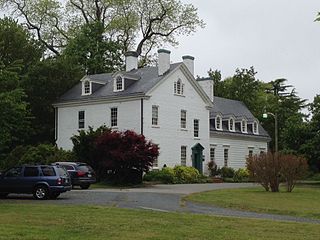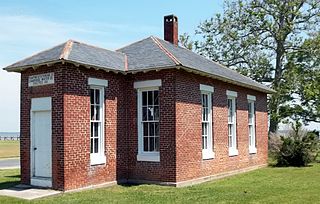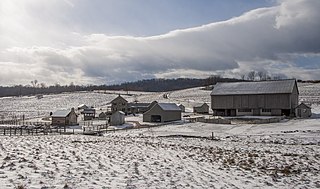Brookefield of the Berrys is a historic house located at Croom, Prince George's County, Maryland, United States. It is a 2+1⁄2-story frame house begun about 1810 in the Federal style, and completed in 1840, in the Greek Revival style. The house was finished in 1840 by John Thomas Berry, a prominent plantation family in southern Prince George's County. Berry and his descendants lived at Brookefield from 1840 until 1976. This 19th-century farmstead is well represented by the complex of outbuildings surrounding the house.

The Cottage is a 19th-century plantation complex located near Upper Marlboro in Prince George's County, Maryland. The complex consists of the principal three-part plantation house with its grouping of domestic outbuildings and four tenant farms, scattered over 282 acres (114 ha). The plantation house has a 2+1⁄2-story main block constructed in the 1840s with a typical Greek Revival style interior trim and distinctive Italianate cornice brackets. Within 150 feet (46 m) to the northwest of the house is a complex of domestic outbuildings, including a well house, ice house, and meat house. It was the home of Charles Clagett (1819–1894), a prominent member of Upper Marlboro social and political society during the second half of the 19th century. He served as a county commissioner following the Civil War.

The Lawyers Hill Historic District is a national historic district located at Elkridge, Howard County, Maryland. The district encompasses a broad array of architectural styles ranging from 1738 Georgian Colonial to 1941 Georgian Revival. The collection of Victorian domestic architecture built during the 1840s to 1880s is unparalleled in the county, with no two houses the same. Some of the later cottages were designed by Philadelphia architect Brognard Okie. There are variations of the American Gothic Revival form, Italianate, Queen Anne, and Shingle-style structures. There is also a range of Colonial Revival houses, from craftsman era rustic cottages to more formal Georgian, and mass-produced Dutch Colonial models from the early 20th century.
Buena Vista, or Bard's Field on Trinity Manor, is a historic home located at Leonardtown, St. Mary's County, Maryland, United States. It is a 2+1⁄2-story, three-bay, Greek Revival-style frame dwelling with a 2-story, three-bay, frame, wing. It was built between 1840 and 1850, for George and Mary C. Combs.

The Inns on the National Road is a national historic district near Cumberland, Allegany County, Maryland. It originally consisted of 11 Maryland inns on the National Road and located in Allegany and Garrett counties. Those that remain stand as the physical remains of the almost-legendary hospitality offered on this well-traveled route to the west.

Christ Episcopal Church and Cemetery is an historic Episcopal church and cemetery located at Cambridge, Dorchester County, Maryland U.S.A.

Bethlehem Methodist Episcopal Church is a historic Methodist church located at Bethlehem, Taylor's Island, Dorchester County, Maryland. It was built in 1857, and is a gable-front common bond brick church across the road from a mid-19th century cemetery.
Brinsfield I Site, or Brinsfield I Prehistoric Village Site, is an archaeological site near Cambridge in Dorchester County, Maryland. The site was first identified in 1955 by Perry S. Flegel of the Sussex Society of Archaeology & History. It is a late prehistoric archaeological site characterized by shell-tempered pottery and triangular projectile points. The site may provide evidence of prehistoric life on the eastern shore of Maryland during the Late Woodland period, c. 900–1500.
Dale's Right is a historic home located near Cambridge, Dorchester County, Maryland, United States. It is one of the few houses which falls under the strict definition of a telescope house, where each section is narrower and shorter than the previous one. Each of the three sections appear to date from the first third of the 19th century, about 1830 to 1840, and they are two, one and a half, and one stories, respectively.

Glasgow is a historic home located at Cambridge, Dorchester County, Maryland. It is a Federal style, gable-front, 2+1⁄2-story brick house built about 1792. Attached is a 1+1⁄2-story frame wing dating from the early 20th century. Local history sometimes holds that the home was the birthplace of William Vans Murray, but land records and Murray's biographical data both indicate that it is unlikely that it was ever his home. It is possible, however, that Murray stayed there for some time after his return from his service as foreign minister in the Netherlands, with his first cousin William Murray Robertson, the owner at the time.

The Goldsborough House is a historic home located at Cambridge, Dorchester County, Maryland, United States. It is a two-and-a-half-story painted brick Federal-style house with a five-bay symmetrical facade, built about 1793. The house features an Ionic columned entrance portico.
Yarmouth, also known as White House Farm, Brick House Farm, and Eccleston's Hill, is a historic home located at Cambridge, Dorchester County, Maryland, United States. It is a two-story Flemish bond brick structure built above a high basement built about 1730. Also on the property is an 18th-century granary.

LaGrange, also known as La Grange Plantation or Meredith House, is a historic home located at Cambridge, Dorchester County, Maryland, United States. It was built about 1760. The house is a 2+1⁄2-story Flemish bond brick house and is one of the few remaining Georgian houses in the town. Sun porches and a frame wing were added to the main house in the late 19th and early 20th centuries. Three outbuildings remain, including a late 19th-century dairy, an 18th-century smokehouse, and a 20th-century garage.

Annie Oakley House is a historic home located at Cambridge, Dorchester County, Maryland. It is a 1+1⁄2-story, brick-and-frame, Colonial Revival–influenced bungalow constructed in 1913. Behind the house is a small garage and studio apartment. The house overlooks Hambrooks Bay, a protected body of water off the Choptank River. It was constructed as a retirement home for Annie Oakley and her husband, Frank Butler, and is the only surviving property in the nation that was either owned or occupied by Oakley as her primary and permanent residence. It features built-in shelves originally intended to display shooting trophies.

Stanley Institute, also known as Rock School, is a historic African American school building located at Cambridge, Dorchester County, Maryland. It is a rectangular one-story, gable-front frame building with a small entrance vestibule built about 1865. Three original blackboards still occupy their proper locations. The building was moved to its present location from a site near Church Creek in 1867. It served as both a church and a school until the erection of the present Rock Methodist Church later in the 19th century.

Dorchester County Courthouse and Jail is a historic courthouse building located at Cambridge, the county seat of Dorchester County, Maryland. It is an Italianate influenced, painted brick structure, which was enlarged and extensively remodeled with Georgian Revival decorative detailing in the 1930s. The building entrance is flanked on the north by a three-story tower. It was constructed in 1853, and is the only courthouse designed by Richard Upjohn in Maryland.

Cambridge Historic District, Wards I and III is a national historic district in Cambridge, Dorchester County, Maryland. It is a large residential, commercial, and governmental area in the northwest section of the city. It consists of buildings from the late 18th through the mid 20th century. Residential building styles include Georgian, Queen Anne, Colonial Revival, and American Foursquare. The district includes the Italian Villa style courthouse designed by Richard Upjohn.

Peter of P. Grossnickel Farm is a historic home and farm complex located at Myersville, Maryland, Frederick County. It consists of a mid-19th-century, Greek Revival farmhouse and 13 related buildings and structures. The house is a 2+1⁄2-story stone center-passage house on a limestone foundation, with a 1+1⁄2-story kitchen wing and 18-inch-thick (460 mm) walls. The house was built between 1840 and 1850. Also on the property is an 1881 tenant house with corresponding barn, spring house, and washhouse / privy; an 1884–1897 bank barn; a pre-1830 granary; a 19th-century wood shed; late-19th-century hog pen / chicken house; a pre-1830 beehive oven; a late-19th-century smokehouse; a spring house with a Late Victorian cottage addition; and early-20th-century concrete block milk house; and a log summer kitchen of unknown date. The Grossnickel family was a German American family who were instrumental in the establishment of the Grossnickel Church of the Brethren.
The Patricia is a Chesapeake Bay log canoe built in 1942 by Oliver Duke. She measures 27'-4" long, and has a beam of 6'-43⁄4". The Patricia has a slightly hollow longhead bow and a sharp stern. Painted white, the canoe races under the no. 19. She is one of twenty-two traditional Chesapeake Bay racing log canoes existing today. The Patricia, and boats like her, carry on a tradition of racing on the Eastern Shore of Maryland that has existed since the 1840s. She is located at Cambridge, Dorchester County, Maryland.

Heighe House is a historic home complex and national historic district at Bel Air, Harford County, Maryland, United States. The complex consists of a Colonial Revival, 2+1⁄2-story stone main house built on and incorporating the stone foundations of the Moores Mill, built in 1745; a 1+1⁄2-story frame chauffeur's cottage; garage; and a 1+1⁄2-story stone and frame guest house. They are all located on a steeply sloping 17-acre (69,000 m2) site along Bynum Run. The property was developed in 1928 as a country estate for Anne McElderry Heighe, a woman widely regarded as the "first lady of Maryland racing."


















